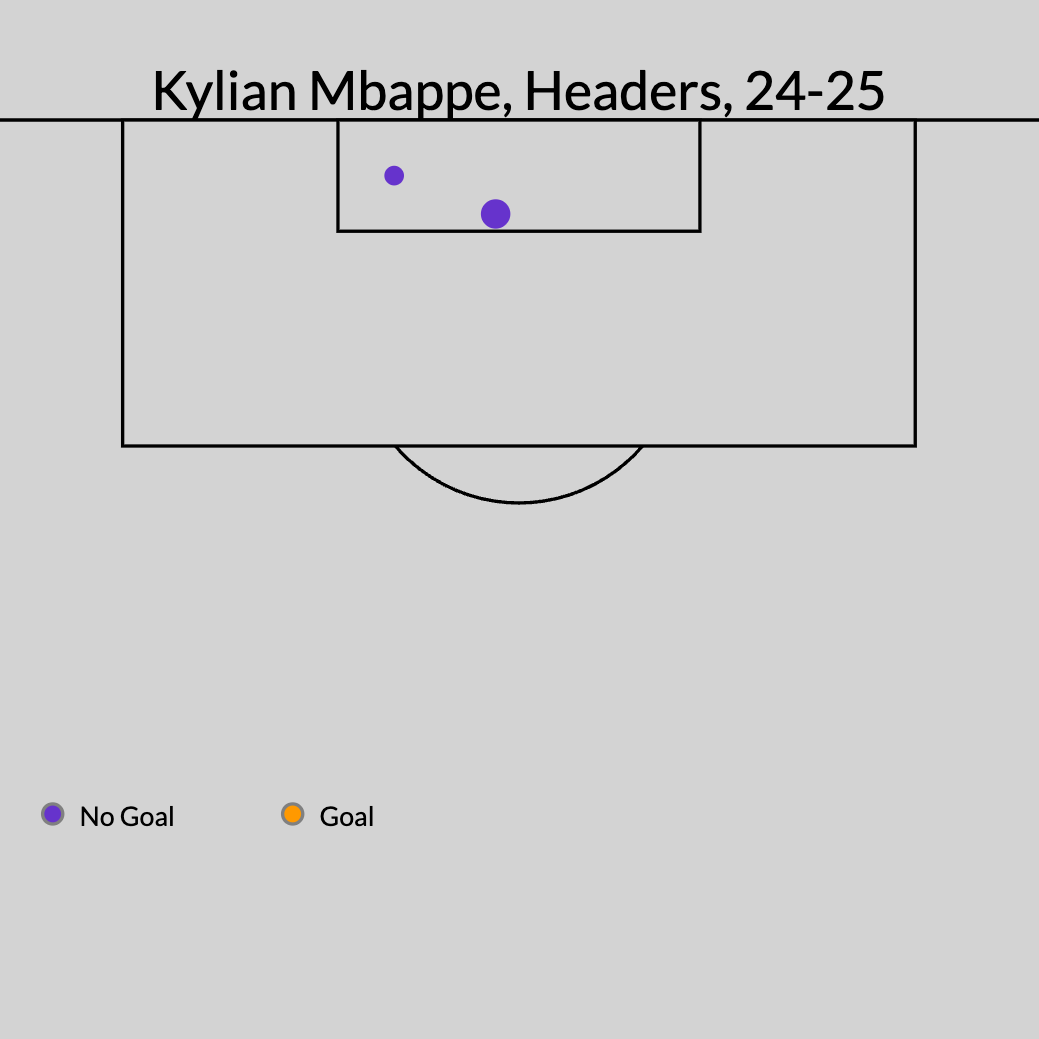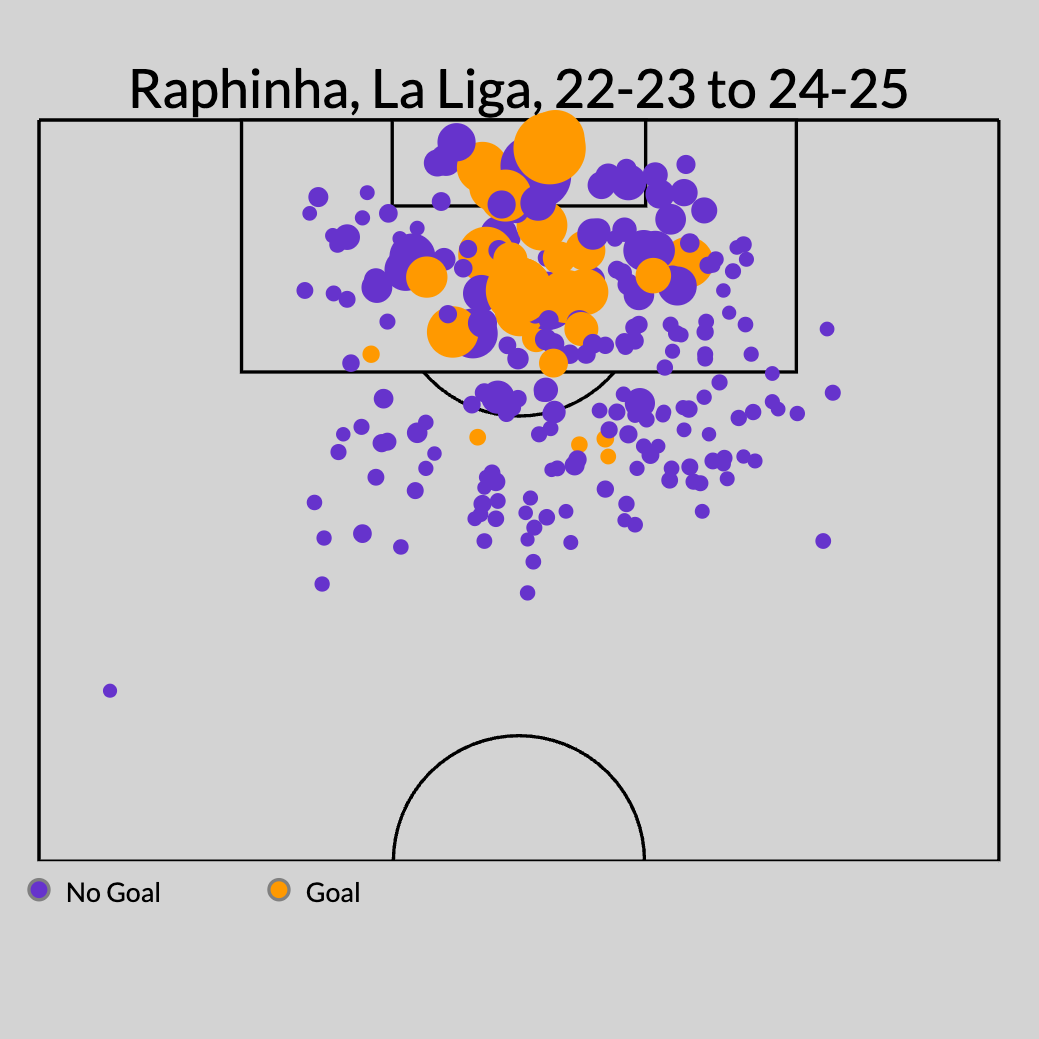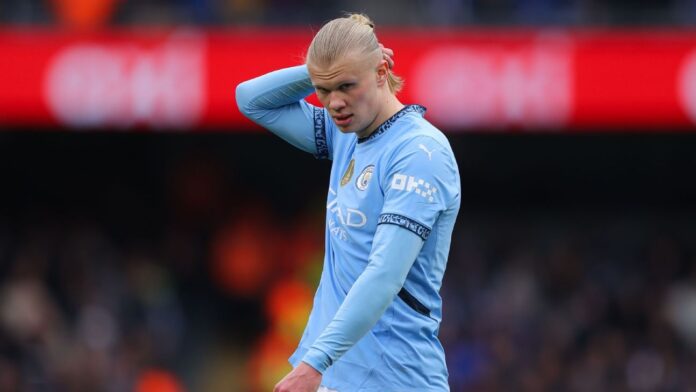What do soccer players do?
There’s an endless list of answers to that question, but if we try to simplify the game down to its component parts, there are six basic actions that make up the majority of what a soccer player does in any given game: They run, they pass, they dribble, they shoot, they jump, and they defend. The beauty of the sport is that each great player is great because of a different mix of these inputs.
Someone like, say, Arsenal‘s Bukayo Saka is above-average at all of those things. He might not be the best in the world at any one, but he is an elite player because he’s simply good at running, passing, dribbling, shooting, jumping, and especially defending. Back in March, I declared PSG’s Ousmane Dembélé the best player in the world for a moment because he was doing pretty much all of those things at an elite level, with both feet.
Other players, though, become world-class and help their teams win lots of points while neglecting one of these six areas — or even actively being bad at one. And today, that’s who we’re going to focus on.
Among the select group of players capable of starting for Champions League-winning clubs, who stinks at passing? Who can’t run? Who won’t defend? Who shouldn’t dribble? Who needs to ignore the crowd when they yell “shoot”? And who is useless in the air?
Introducing: the worst best players in the world.
Can’t run: Harry Kane, Bayern Munich
Somewhere around the 2018 World Cup, Harry Kane lost his explosiveness.
Before then, he fit right in with Tottenham‘s physical, beat-you-up high press under manager Mauricio Pochettino. He was electric on the counter, and he was so powerful that he’d easily create his own shots around the penalty area, too. In the 2017-18 season, he attempted 5.3 shots per game and he received 7.6 progressive passes.
He hasn’t been close to either number since. This year with Bayern Munich, he’s down to 3.9 shots and 5.3 progressive passes received. That, too, is with a much better and much more dominant team than Spurs were.
We still probably don’t talk enough about how Kane completely reinvented his game in order to remain a world-class player. The avalanche of shots and runs into space went away, and he replaced all that value by taking shots from closer to the goal, and by dropping deeper and playing dangerous passes for his teammates to run onto.
Now, at age 31, he’s barely running at all. Per data from PFF FC, Kane is sprinting 14.34 times per 90 minutes in the Bundesliga — 41st among 45 qualified center forwards. In the Champions League, he made 12.83 sprints per 90 — last among the 43 center forwards who played at least 450 minutes.
With Bayern Munich clinching the Bundesliga over the weekend, perhaps Kane can provide a lesson to anyone else who is haunted by their own incredibly specific curse: it won’t end until you stop trying to run away.
Can’t jump: Kylian Mbappe, Real Madrid
Since the start of last season, 19 forwards have scored at least 30 goals across Europe’s Big Five top leagues. All of those players have won at least 15 aerial duels and attempted at least 41.
Except for Kylian Mbappe. He’s won three headers and only attempted 10 aerial duels. Despite not suffering any major injuries and playing most of the season as Real Madrid‘s nominal center forward, these are all the headed shots he’s attempted in 2024-24:

Now, he’s still had an amazing individual season — the best in Europe, by at least some metrics. And “jumping” is easily the least valuable skill or action of the six we’re talking about today.
But Mbappe’s complete inability to challenge for anything in the air is representative of his larger issues as a winning player at the highest level: his presence requires a certain set of tactics, and a specific profile of teammates.
Doesn’t defend: Mohamed Salah, Liverpool
Mohamed Salah is genuinely having one of the best seasons you’ll ever see. He’s leading all players across the Big Five leagues in goals, assists, and of course: goals plus assists. The gap between Salah (46) in first and Kane (32) in second is the same size as the gap between Kane and the 13 guys tied for 18th.
Not only that, but Salah’s also third among all players in passes into the penalty and first in touches inside the penalty area. He scores goals, he creates goals, he runs off the ball to find space in the box, and he completes passes into the box. That’s Lionel Messi stuff, just without all the extra work in buildup play.
1:38
Can anyone challenge Mohamed Salah for Player of the Season?
Ian Darke and Beth Lindop explain why Mohamed Salah has to be considered the Premier League Player of the Season.
We often talk about how soccer is a game of trade-offs at the team level, i.e. the more you attack, the more likely you are to concede goals. But that sometimes applies at the individual level, too. You stop contributing in one area — or you focus on training one aspect of your game over another — because of a higher potential payoff elsewhere. And well, Salah just had the best season of his career at age 32 because he stopped defending.
Don’t take it from me, either. Take it from him: “You can see the numbers,” Salah said, after Liverpool clinched the Premier League title against Tottenham last weekend. “Now I don’t have to defend much. The tactics are quite different. I said, ‘As long as you rest me defensively, I will provide offensively,’ so I am glad that [Arne Slot] did. He listened a lot, and you can see the numbers.”
It shows in the numbers on the defensive end, too. Among attackers to make at least 10 starts in the Premier League this season, per PFF FC, Salah has sprinted the fewest times per 90 minutes (3.82) while his team is out of possession.
Can’t dribble: Lautaro Martinez, Inter Milan
During the round of 16 of the Champions League in 2021-22, there was a hilarious moment in the first leg of the tie between Liverpool and Inter Milan. Lautaro Martínez received the ball some 45 yards from goal — ahead of every Liverpool player except for Virgil van Dijk.
It’s every forward’s dream — tons of space, an opportunity to beat a famous defender, and then a 1v1 with the keeper to take the lead against one of the best teams in the world. And so Martinez took a couple touches toward van Dijk … and then just kind of gave up. He dribbled away from the goal, slowed down to allow his teammates to join the play, and then lost possession to a recovering Liverpool midfielder.
Plenty of people made fun of it in the moment, but I think he was making a mathematically sound decision. Van Dijk is arguably the hardest defender to dribble past in the history of the sport and Martinez, while a fantastic and super-productive attacker, just isn’t a very good dribbler.
Among all the forwards who have played at least 900 minutes across Europe’s Big Five leagues this season, Martinez ranks 200th for the possession value he’s added from take-ons this season, per Stats Perform. That number is slightly negative, at minus-0.05, meaning that all of Martinez’s attempted dribbles this season have actually decreased Inter’s chances of scoring a goal.
Can’t shoot: Raphinha, Barcelona
Yeah, OK, I saw Raphinha smash a ball into the crossbar with the force of a small anti-aircraft missile last week. No, I can’t remember the last time I saw a shot make the goal frame shake. And sure, when the ball hit the crossbar it sounded like someone had just driven a motorcycle into a chain-link fence.
But that’s part of what made Raphinha’s “goal” against Inter Milan so special: he misses way more often than he scores. And I don’t just mean that shot; I mean all shots.
At this point, everyone agrees that Raphinha is having a world-class season. He’s got 19 goals and nine assists in LaLiga, plus a ridiculous 12 and eight in the Champions League. He runs more than just about anyone in the world. He’s one of the best pressing wingers of this generation. The only problem? Compared to the sport’s other stars, he can’t shoot.
Among the 36 players across Europe’s Big Five leagues who have at least 50 goals+assists since the start of the 2022-23 season, just six have more expected goals than actual goals. Raphinha is the only one to undershoot his xG, or expected goals, by at least three, and he’s 4.4 behind the pace: 29 goals from 33.4 expected.

I’m not just roping in the last two seasons to make him look bad, either. He’s 0.7 behind the pace this year and was 1.4 back last season and 2.3 goals behind in his first season in Spain. In the four seasons before that, with Leeds, Rennes, and Sporting Lisbon, he was pretty much exactly on his xG number, which is still below average since most attackers finish at a higher rate than players at other positions.
But that’s only in LaLiga. In the 13 Champions League matches this season, Raphinha has scored those 12 goals off just 5.7 xG. If he has suddenly become a great finisher, then, well, he’s going to be one of the Ballon d’Or favorites for at least a couple more years.
Can’t pass: Erling Haaland, Manchester City
In the Premier League this season, Manchester City have attempted around 2,000 more passes than every other team. And yet, somehow, their starting center forward attempts just 12.38 passes per game — the fewest of any player at his position in the Premier League.
Two of City’s January signings, Abdukodir Khusanov and Nico Gonzalez, have attempted more passes than Erling Haaland. And so has Nico O’Reilly, who started his first career Premier League game on April 2 … of this season.
Put another way, Nottingham Forest have attempted the fewest passes in the league this season — about 10,000 fewer than City. And yet their center forward, the similarly hulking and one-note Chris Wood, has attempted 419 passes to Haaland’s 341. I need to see Haaland play for a team coached by Nuno Espirito Santo. Could he score 30 goals in a season without attempting 30 passes?
It’s not just that Haaland doesn’t pass the ball; it’s that good things also rarely happen when he does. Although Haaland touches the ball inside the penalty area about seven times per match, he’s turned that into just 0.08 expected goals worth of passes per game. That’s good enough for about three assists per season — if he plays every minute of every game.
He completes barely more than two-third of his passes, and among center forwards with at least 250 passes attempted this season, Haaland has the third-worst PFF FC grade: 56.7 out of 100.
Frankly, this entire piece could’ve been about Haaland. When he came to England, his game was a little more well-rounded, but whether by choice, by design, or by circumstance, everything else has fallen by the wayside in pursuit of goal-scoring at City. He can’t beat anyone one on one, he doesn’t defend, he doesn’t win balls in the air, and while he is one of the fastest players in the world, he still only sprints about as often as Harry Kane does.
Haaland takes a ton of shots and scores a ton of goals — and that’s it.

















